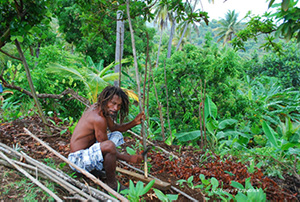Hidden Black History Highlighted on Explore Jax Core Tour

Tour Guide "Yollie" Copeland of Explore Jax Core Tours Photo: Vanessa Orr
By Vanessa Orr
Posted February 21, 2025
Yolanda ‘Yollie’ Copeland is a woman with a mission. The retired sheriff’s deputy, who moved to Jacksonville, Florida in 2013, is committed to making sure that the city’s rich Black history isn’t erased. She does it by tooling around town in an advertising-covered, low-speed electric vehicle, wearing a bright yellow shirt, shoes, and hat, and sharing her love for the area and the people who shaped it.
The Explore Jax Core Tour
Spending time with Yollie is an adventure in itself. A cheerful ball of energy, she seems to know everyone she sees on the street and stops her narration long enough to check in on their health or their kids, all the while smiling and laughing. Even though the subject matter of her mesmerizing “Explore Jax Core” tour isn’t always happy, Yollie’s infectious positivity makes the three-hour tour fly by and leaves visitors wanting more.
A prime example of this is in James Weldon Johnson Park, where the Explore Jax Core tour begins. The oldest park in the city, it is also the site of Ax Handle Saturday, where on August 27, 1960, over 200 white rioters armed with baseball bats and ax handles chased and beat Black residents in response to a peaceful lunch counter demonstration organized by the Jacksonville Youth Council of the National Association for the Advancement of Colored People (NAACP).
“This event was not memorialized until 1980 after being swept under the rug for many years,” said Yollie, adding that the park was renamed in 2021 for Weldon Johnson, a Jacksonville-born civil rights activist, writer, professor, and first Black leader of the NAACP, following the 2020 killing of George Floyd. Johnson is also immortalized at another stop on the tour, Lift Every Voice and Sing Park, named for the National Black Anthem written and composed by Johnson and his brother, John Rosamond Johnson.

Mosaics by Celso celebrate Jacksonville hometown heroes at the Jessie Ball duPont Center, including Zora Neale Hurston & Elbony Payne-English Photo: Vanessa Orr
Riches Erased
In its heyday, Jacksonville served as the home to some of the richest Black businessmen in the country. Sugar Hill, for example, was, per capita, the wealthiest neighborhood in Florida during the 1920s. Numerous Black millionaires, including Abraham Lincoln Lewis, who was born enslaved but later became the first Black millionaire in Florida, and Joseph Blodgett, a Black architect who built over 200 homes, lived here.
“At one point, mansions owned by Black people lined the streets, but now all that’s left of these buildings are the memories of a better time,” said Yollie, noting that the one remaining mansion in Sugar Hill is now home to Alpha Kappa Alpha sorority.
By choosing to route the Jacksonville Expressway (now part of I-95) through prosperous Black neighborhoods in the 1940s, the federal government erased more than 300 Black-owned businesses and communities. This includes Hansontown, established in 1866, and named after physician Daniel Hanson, a doctor assigned to the colored troops. That land now serves as the home of Florida State College of Jacksonville.
“There were many other places where the government could have put the highway,” said Yollie of Sugar Hill and Hansontown’s destruction. “But they chose urban removal instead; running it directly through Black communities.”

Ritz Theater in LaVilla: One of the few remaining entertainment sites from its heyday as “The Harlem of the South” Photo: Vanessa Orr
The Remnants of a Community
She notes that when towns are ‘reurbanized,’ only four things remain: doctors’ offices, churches, funeral homes and schools. In Jacksonville, this includes Bethel Church, home to the oldest Baptist congregation in the city, and also the church where Johnson’s brother composed the music for Lift Every Voice and Sing.
The tour also travels through LaVilla, an area decimated in 1901 by a fire that started in a mattress factory. The majority of the city burned because first responders only protected the properties of white owners, allowing the flames to spread.
Once considered the “Harlem of the South,” LaVilla later attracted such noteworthy artists as Duke Ellington, Etta Fitzgerald, Billie Holiday, Louie Armstrong, and Ray Charles. Some of these legendary artists performed in the 1930s Ritz Theater, which still stands.
“It’s hard to believe that this was once known as the street that never slept, and now it’s just an abandoned site,” said Yollie.

Black leaders Rutledge Pearson & Rodney Lawrence Hurst, Sr. are immortalized on mosaic art pieces at the Jessie Ball duPont Center Photo: Vanessa Orr
Keeping Their Memories Alive
While today’s city center doesn’t look anything like it did in its heyday, it is still a beautiful place to visit, especially as the city is now making efforts to pay tribute to the Black leaders who came before.
A number of Jacksonville hometown heroes are enshrined in mosaic form at the Jessie Ball duPont Center. There, artist Celso has recognized anthropologist, educator, and first female African-American president of Spelman College, Dr. Johnnetta Betsch Cole; humanitarian, philanthropist, and businesswoman Eartha M.M. White, who parlayed the more than $1 million she made back into humanitarian causes; Rodney Lawrence Hurst, Sr., a civil rights activist, author, and historian; baseball star Rutledge Pearson, a civil rights leader, coach and educator; Ebony Payne-English, a poet, lyricist, playwright and educator, and Zora Neale Hurston, an anthropologist, folklorist and novelist.

J.P. Small Memorial Stadium: Located on the former Durkee Field, the home of the Negro American League’s Jacksonville Red Caps Photo: Vanessa Orr
Historic Black Neighborhoods
Durkeeville, a historic black neighborhood, includes the J.P. Small Memorial Stadium, which sits on what was once known as Durkee Field, the home of the Negro American League’s Jacksonville Red Caps. Dating back to 1912, Hank Aaron once played on this field and met his future wife in Durkeeville. While playing for the Jacksonville Braves, Aaron, Felix Mantilla, and Horace Garner broke baseball’s ‘color line’ in the south in 1953.
Emmett Reed Park, the first Black park in Jacksonville, still exists and provides a captivating mystery for those interested in Black history. Known as Mt. Herman Cemetery in 1898, the Black cemetery became a park in 1969. Only a few tombstones remain; those of the Fagin family and one for Thompson Williams, “a Negro who died from wounds received while endeavoring to protect the honor and the life of a white woman.”
“What happened to the other bodies?” asks Yollie. “In 1898, this was a whole cemetery.”
While much of Jacksonville’s Black history has been erased over the past century, Yollie intends to preserve all that she can through her tours by sharing the stories of those who created such a vibrant, successful community. Through her efforts, these Black leaders will never be forgotten. For more information on Yollie’s tours, visit www.explorejaxcore.com.
Click Here for Discounted Accommodations in Jacksonville, FL
Join the community!

Join our community to receive special updates (we keep your private info locked.)




